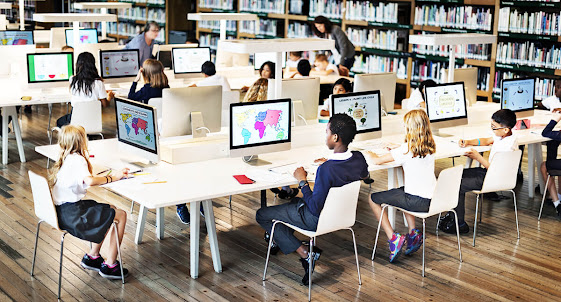Benefits of digital classroom
Technology attracts children beyond measure these days, and if they can obtain endless amusement from it, institutions must reconsider their paradigm and use technologies to create instruction effectively while also entertaining. It is a well-known truth that edtech solutions help new-generation students learn more. Digital learning is the fastest expanding area in the education business, with a 900 percent increase since 2000.
The widespread use of the internet has resulted in the traditional classroom being replaced with a digital learning environment. Many classroom teaching settings have made the switch to digital learning systems around the world. The most prevalent situation is one that incorporates a digital component into a traditional classroom setting.
What is the definition of digital learning?
Digital learning employs new tools and methodologies available at good schools to assist students in learning in new ways. This new method of education is quickly displacing the more traditional method of "face-to-face" instruction.
The usage of ipads or tablets in the classrooms rather than traditional notebooks and papers can be a simple way to incorporate digital learning.
It can also entail the use of sophisticated software and hardware to enable students to access areas of education that were previously unavailable to them. The possibilities for using digital goods and services for academic purposes are endless, and the benefits to students are enormous.
Improved Accessibility
Accessibility is one of the key benefits of a digital classroom. Students must gather in a certain location and study from an instructor in traditional classrooms. The majority of time, these teachings aren't saved for later use. Even if they are gone for a day, students who are unable to commute or attend courses may miss out on teachings.
Digital classrooms fill this void by being accessible at any time and from any location. Students can use a connectible device to attend lessons from the convenience of their own homes. They can always go back and watch recorded sessions if students miss a lecture. This also allows them to revise more effectively without having to look for content from many other places.
Accountability has increased
A digitalized class makes giving class examinations and providing feedback much easier. Instructors can maintain track of the progress because each student will have their own record in a virtual system. You may check each student's progress by evaluating their watch time if you've uploaded educational content to the digital classroom system.
You can also use webcams and microphones to conduct online assessments and supervise students. The technology also allows you to post each student's results and feedback into a central location, which each student can access through their individual accounts.
Students can be made responsible for their performance because the data can be accessible at any moment. It's also simple to share data with their families and other teachers because everything is in one location.
Learning at Your Own Pace
Every kid learns at a different speed and in a different way. And there's only so much adaptability you can achieve with in-person training. Rather than focusing on a single student, most traditional classrooms focus on a group of pupils. Despite the fact that instructors are accessible after class, students who require a slower pace may feel left behind.
Virtual classrooms offer the ideal combination of structure and flexibility. Kids can learn through their own speed because they can access content at any time. They can also replay the content or request additional resources if the information provided is insufficient. This guarantees that each student comprehends the subject while remaining on track with the rest of the class.
Students become smarter.
Students can build good self-directed learning skills using virtual learning tools and techniques. They can now determine what they want and need to learn, locate and use online technologies, apply what they've learned to the situation at hand, and even analyse comments. This boosts their productivity and efficiency.
The tools and strategies employed in the online classroom not only engage students, but they also sharpen the critical reasoning skills needed to create analytic reasoning.
Lessons That Are More Engaging
An iPad app is used by a child to learn. A classroom, textbooks, papers, one teacher, and pupils are all part of the traditional educational concept. There was a chalkboard and chalk in the old days; today there's a whiteboard with squeaking pens.
It's a model we're all familiar with, but those of us who have completed our formal education know that it wasn't always the most entertaining way to learn. Learning can be delivered in a variety of ways with digital learning. audio, video and Imagery, All of these things can be easily integrated into a lecture.
Some instructors are indeed able to locate software in the shape of games that complements the subject they are teaching.




Comments
Post a Comment